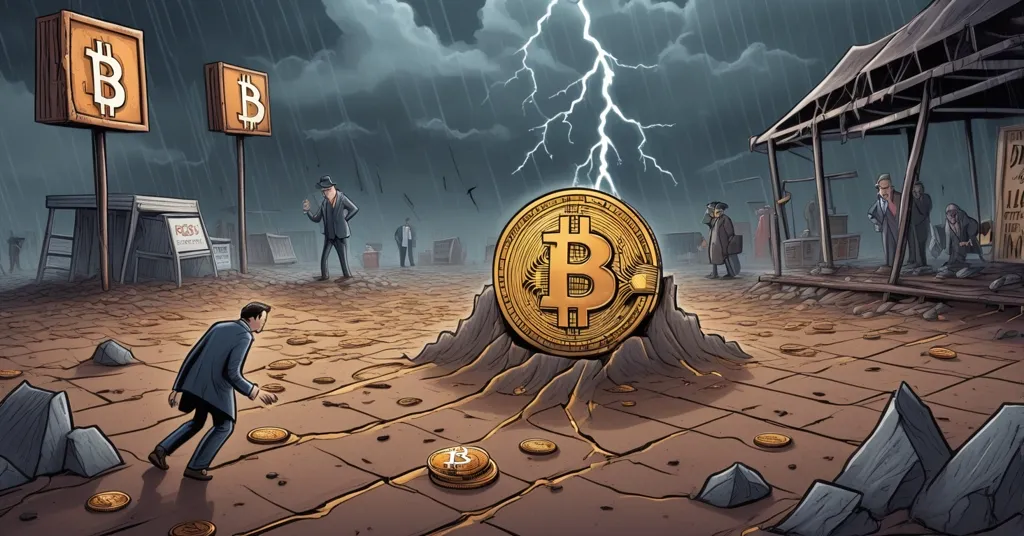Bitcoin Price Struggles: Long-Term Holders Sell Amid 2024 Demand Drought

Bitcoin’s Price Woes: Long-Term Holders Sell, But Demand Drought Steals the Show
Bitcoin, the pioneer of decentralized money, is grappling with a rough patch in November 2024, slipping below the psychologically charged $100,000 level for the second time in a week on November 7. Though it’s since rebounded to around $103,700—a modest 3% uptick in 24 hours—the volatility raises eyebrows in what should be a roaring bull market. What’s behind this shaky footing, and why isn’t the usual playbook working?
- Price Volatility: Bitcoin dipped below $100,000 on November 7, testing investor nerves at a key psychological threshold.
- Holder Behavior: Long-term holders (LTHs) have been offloading since October, a standard move to lock in profits during bull runs.
- Demand Crisis: Unlike past cycles, there’s no significant buying pressure to counterbalance the selling, resulting in negative apparent demand growth.
- Recovery Hopes: A price rebound hinges on a resurgence of positive demand, but catalysts remain uncertain.
Long-Term Holders: Cashing Out or Playing Smart?
Let’s start with the usual suspects: long-term holders, or LTHs—those Bitcoin diehards who’ve clung to their coins through bear market bloodbaths and regulatory storms. These are the folks with so-called “diamond hands,” refusing to sell even when the market looks like a dumpster fire. But when the bulls stampede and prices spike, history shows they’re not above cashing out. According to Julio Moreno, Head of Research at CryptoQuant, who shared his insights on X, LTHs have been selling steadily since October. And honestly, who can blame them? When Bitcoin’s flirting with six figures, locking in gains is just good business. It’s not betrayal; it’s basic math. For deeper insights into this trend, check out this analysis on why long-term holders often sell during bull markets.
Here’s the kicker, though: LTH selling isn’t a death knell for Bitcoin. It’s a recurring theme in every bull cycle. These holders often act as a stabilizing force, accumulating during lows and distributing during highs, which can prevent insane bubbles—or at least delay the inevitable pop. In past runs, like early 2024 or late last year, their selling coincided with Bitcoin smashing all-time highs. So why isn’t that happening now? The answer lies not in their behavior, but in who’s not showing up to the party.
Demand Drought: Why Aren’t Buyers Stepping Up?
Picture a bustling fruit market. Farmers keep bringing in fresh apples (mined Bitcoin), and some old-timers are selling off their stockpiles (LTHs). Normally, hungry buyers snap up the supply, keeping prices steady or even pushing them higher. But right now, the crowd’s gone. There’s more fruit than anyone wants, and prices tank. That’s the essence of “apparent demand growth,” a metric Moreno highlights as the real villain here. It measures the gap between Bitcoin being acquired and what’s freshly mined. When it’s positive, demand outstrips supply, and prices often climb. When it’s negative—as it is now—more Bitcoin floods the market than people are willing to buy. Result? Stagnation or decline, no matter how high the hype.
For newcomers, let’s clarify: every day, miners create new Bitcoin as a reward for securing the network, adding to the circulating supply. After the 2024 halving—an event that slashes these rewards roughly every four years to curb supply growth—you’d expect scarcity to drive prices up. But without buyers, even a tighter supply can’t spark a rally. CryptoQuant’s data shows this demand drought is starkly different from earlier this year, when positive demand growth fueled record highs despite LTH sales. So, what’s keeping buyers away? Retail investors might be burned out after recent gains, institutional players could be spooked by macroeconomic jitters, or maybe everyone’s just waiting for a clearer signal. Whatever the reason, this imbalance is Bitcoin’s Achilles’ heel right now.
Historical Context: What Past Cycles Tell Us
Bitcoin’s been here before, or at least somewhere close. Cast your mind back to the 2017 bull run—LTHs sold off in droves as prices neared $20,000, only for the market to crash hard in 2018 before staging a comeback. Earlier in 2024, between January and March, LTH selling didn’t stop Bitcoin from scaling new peaks because demand was there to cushion the blow. Same story late last year, November to December, when apparent demand growth stayed positive. History suggests Bitcoin can weather profit-taking if fresh money keeps flowing in.
Fast forward to now, and the post-2024 halving landscape should be a tailwind. Halvings cut miner rewards in half, reducing new Bitcoin entering circulation and theoretically boosting scarcity. But theory’s one thing; reality’s another. Without demand, scarcity is just a buzzword. Are we staring at overvaluation fears after a rapid climb? Has the retail FOMO—fear of missing out, that irrational rush to buy before prices moon—faded into caution? Or are bigger forces, like inflation data or central bank moves, keeping wallets shut? These unanswered questions linger like a bad aftertaste.
External Pressures: The World Beyond the Blockchain
Bitcoin doesn’t exist in a vacuum. It’s a rebellious middle finger to centralized finance, sure, but it’s still swayed by the same macro winds that buffet stocks and bonds. November 2024 comes on the heels of global economic uncertainty—think stubborn inflation, interest rate hikes, and geopolitical chess games. If the US Federal Reserve signals tighter policy, or if post-election vibes in major economies turn sour, institutional cash might stay on the sidelines. Retail players, meanwhile, could be nursing losses or just tired of the rollercoaster. Let’s be blunt: FOMO can flip to greed in a heartbeat, but it can also leave the market high and dry when confidence wanes.
Then there’s the on-chain perspective. Are whales—those big-time holders with deep pockets—accumulating quietly while retail hesitates? Tools like Glassnode or Whale Alert often show spikes in large transactions before price moves, but recent silence suggests even the big fish are playing it safe. And don’t get me started on the Twitter “gurus” promising $200K by New Year’s. Ignore the noise. Wild price predictions are usually just shilling masquerading as insight. Focus on fundamentals, not fantasies. The real question is whether external catalysts—say, a surprise ETF approval or a central bank misstep driving adoption—can reignite demand before the next dip.
What’s Next for Bitcoin and the Crypto Frontier?
Recovery isn’t a pipe dream, but it’s not a given either. Bitcoin’s resilience at $103,700 hints at stubborn support, yet it’s hardly a triumph. For a true rally, apparent demand growth must flip positive. That could come from institutional buy-ins, regulatory clarity (imagine a pro-crypto policy shift), or even tech breakthroughs like Lightning Network scaling, which makes Bitcoin faster and cheaper for everyday use. Network fundamentals remain rock-solid—hash rate, a measure of mining power securing the blockchain, is near all-time highs, and active addresses show steady adoption. Short-term pain doesn’t erase long-term promise.
Zoom out, and Bitcoin’s stumble could ripple across the crypto space. As the market’s bellwether, its demand woes might cool enthusiasm for altcoins like Ethereum or Solana unless they carve out unique narratives—think DeFi innovation or real-world utility. Conversely, Bitcoin’s struggle could be their opportunity to shine if they solve problems faster. Either way, this moment tests the ecosystem’s maturity. If pain today sparks progress tomorrow—whether through Bitcoin upgrades or altcoin breakthroughs—that’s a win for decentralization. Call it effective accelerationism: sometimes, a kick in the teeth forces you to run faster.
Playing devil’s advocate for a second, what if LTH selling isn’t a crisis but a sign of Bitcoin growing up? Maybe it’s evolving into a true store of value, where profit-taking is natural as holders treat it like gold, not a lottery ticket. Fair point—except without demand to backstop those sales, maturity looks more like stagnation. Markets don’t reward intent; they reward action. Buyers need to show up, or this coming-of-age story gets a grim ending.
Key Takeaways: Unpacking Bitcoin’s November 2024 Challenges
- Why is Bitcoin struggling to hold above $100,000 in 2024?
A lack of buying pressure to offset selling by long-term holders has led to negative apparent demand growth, stalling price momentum. - Is long-term holder selling a warning sign for Bitcoin?
Not necessarily—it’s typical during bull markets as investors secure profits, but it hurts when no one’s buying the dip. - How does apparent demand growth shape Bitcoin’s price trends?
It’s a critical gauge of market health; negative growth means supply outpaces demand, dragging prices down until buyers return. - What could spark a Bitcoin price recovery?
Renewed demand from retail or institutional players, fueled by positive news like ETF approvals or regulatory wins, could turn the tide. - Will Bitcoin’s demand issues impact other cryptocurrencies?
Likely, since Bitcoin often sets the market tone; altcoins could suffer or seize the chance to stand out with innovation. - Should we trust Bitcoin price predictions during this volatility?
No—most are speculative nonsense; stick to data like on-chain metrics and fundamentals over hype-driven forecasts.
Bitcoin’s current bind boils down to a brutal truth: selling pressure from long-term holders isn’t the problem; the gaping hole where demand should be is. Markets thrive on belief as much as code, and right now, belief looks thin. Still, if history’s any guide, Bitcoin has a knack for defying the odds. The question hanging over us is simple but heavy—will the buyers return in time, or are we bracing for a colder stretch than anyone expected? Keep watching the signals. The next move could come from anywhere, and when it does, you’ll want to be ready.



